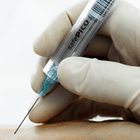Printed from acutecaretesting.org
March 2007
Inadequate mixing – a potential preanalytical error revealed
Summarized from Grenache DG, Parker C. Integrated and automatic mixing of whole blood: An evaluation of a novel blood gas analyzer. Clin Chim Acta 2007; 375: 153-57
Accurate blood gas results depend on a homogeneous blood sample and the necessity for thorough mixing of samples is reflected in written standard operating procedures for blood gas analysis. The results of a recent study suggest, however, that manual mixing techniques routinely used may be inadequate in achieving a truly homogeneous sample.
Two mixing techniques (automatic and manual) were compared. The automatic technique depends on the presence of a small metal ball located in the barrel of the specimen-containing syringe. This ball is rotated through the sample for 7 seconds by the action of an externally located magnet.
No standard technique for manual mixing was adopted for the study but instead, as is the case in routine practice, was left to the discretion of the experienced technologists performing the analysis.
To compare the homogeneity of samples mixed automatically with those mixed manually, hemoglobin concentration was measured using blood gas analyzers, in paired samples from 180 patients. Half of the paired samples (90) were measured immediately after automatic mixing and the remaining 90 paired samples were analyzed immediately after manual mixing.
For both mixing techniques a third of the paired samples were stored horizontally for 10 minutes prior to mixing, a third stored 20 minutes and final third stored 30 minutes prior to mixing.
The mean absolute difference in hemoglobin concentration between paired samples mixed manually was 6.0 g/L (range 1.0-55) for samples stored 10 minutes, 3.0 g/L (range 0-28) for samples stored 20 minutes and 6.0 g/L (range 0-27) for samples stored 30 minutes.
For all three storage times there was by contrast very little difference in hemoglobin concentration between paired results of samples mixed automatically: mean absolute difference was 0.4 g/L (range 0-5.0) for samples stored 10 minutes, 0.3 g/L (range 0-2.0) for samples stored 20 minutes and 0.2 g/L (range 0-1.0) for samples stored 30 minutes.
Clearly the samples mixed manually by non-standardized technique were not as homogeneous as those mixed automatically. In a second experiment it was demonstrated that it is possible to increase the homogeneity of manually mixed samples by adopting a rigorous manual mixing technique. The homogeneity of samples continuously inverted and rolled through the palm of the hands for 2 minutes, was shown to be the same as samples mixed automatically.
May contain information that is not supported by performance and intended use claims of Radiometer's products. See also Legal info.







